Abstract
Layered double hydroxides (LDHs) can be used in various popular fields due to their good biocompatibility, easy chemical modification, and high theoretical specific capacity. However, for different applications, there are different requirements for the morphology of LDH nanosheets. In this paper, the crystal morphological control and the exfoliation states of LDHs are investigated. The interlayer spacing of LDH decreases with the increase of intercalating ion affinity, exhibiting difficulty in being exfoliated into nanosheets. The calculated binding energies between LDH laminates and intercalated ions CO32−, Cl−, and NO3− are 0.311 eV, 0.301 eV, and 0.071 eV, respectively. LDH-NO3− with complete hexagonal shape and high crystallinity can be prepared under the condition of Co:Al:urea = 3:1:10, 90 °C, and 48 h. In the preparation of LDH-NO3− with high saturation co-precipitation method, formamide acts as an effective layer growth inhibitor. When the formamide content is 50%, the size of formed LDH nanosheets is significantly reduced by 28.1%, and when the formamide content is up to 100%, it is further reduced by 7.0%. The addition of formamide can also inhibit the generation of byproducts. The addition of NaNO3 leads to a stronger monodispersity of LDH nanosheets. By comparing CoAl-LDH, MgAl-LDH, and ZnAl-LDH, lower standard molar Gibbs free energy results in a larger nanosheet with high saturation co-precipitation method, but the alteration of M2+ exhibits negligible difference in the size and shape by means of homogeneous co-precipitation.
1. Introduction
Layered double hydroxides (LDHs) are a class of layered materials consisting of positively charged brucite-like sheets; the positive charge is due to the substitution of M2+ cations by M3+ cations [1,2]. In the interlayer of LDHs, anions, as the main species for balancing the charge, can exchange with a variety of other anions [3]. Due to the controllability and multifarious of structure, LDHs can be applied in various fields [4,5,6]. The morphology of LDHs plays a significant role in many different applications. For example, the introduction of anti-inflammatory anions can enable LDHs to function as drug carriers and drug releasers. The size of LDH nanosheets should be controlled below 100 nm for efficient delivery to most cells [7,8,9,10]. Based on memory effects, LDH is also required to be small for rapid structural reversion in some applications [11,12]. Zhang et al. [13] used the memory effect to prepare a new LDH nanostructure (100–200 nm) which contains effective flame retardants of polyoxometalates and further improves the flame retardancy. For some membranes prepared with exfoliated LDHs nanosheets, a large aspect ratio of LDH is required. Liu et al. [14] prepared CoAl-LDH-CO32− with a diameter of 4 μm and assembled layer by layer on the quartz glass substrate to produce composite films. Song et al. reported that the exfoliated single-layer nanosheets exhibit higher oxygen evolution activity than the corresponding bulk LDHs in alkaline conditions [15]. Particularly, in the field of two-dimensional nanomaterials, LDHs are irreplaceable positively charged sheets which are in sharp contrast to other negatively charged 2D materials such as MoS2, graphene, MXene, C3N4, and clay mineral (montmorillonite, vermiculite, etc.) [16,17].
In addition, there are those with less stringent size requirements but different morphologies. Three-dimensional flower-like morphologies can provide a large number of active sites, and LDH containing Ni or Co are electrochemically active and can store energy through Faradaic redox reactions [18,19]. Shang et al. [20] reported a staggered structured LDH with nanorods and nanosheets. The staggered structure can effectively enhance capacitive performance by providing a suitable pore structure, well-exposed reaction sites, and fast electron transfer.
The structure of LDH largely depends on the morphology of interlayer molecules and further affect the morphology of the nanosheets [21,22]. Although morphology has a great impact on performance and application, there is little research on morphology control during the synthesis of LDHs. In this paper, the crystal morphological control of LDHs prepared by co-precipitation method is investigated. LDH-CO32− which can be exfoliated after ion exchange, LDH-NO3− which can be directly exfoliated, and LDH nanosheets which do not need to be exfoliated are introduced. In addition, the effect of different ion intercalation on LDHs and the factors affecting the formation of LDH crystals are investigated, including metal ratio, alkali content, and growth inhibitor. CoAl-LDH, MgAl-LDH, and ZnAl-LDH were prepared using high saturation co-precipitation and uniform co-precipitation, respectively, and the effect on grain size and unit cell parameters are explored.
2. Experimental
2.1. Sample Preparation
2.1.1. Exfoliation-Able CoAl-LDH-CO32− Synthesized with Homogeneous Co-Precipitation and Ion Exchange Method
CoAl-LDH-CO32− crystals were prepared by the homogeneous co-precipitation method. First, 4 mmol cobalt chloride (CoCl2·6H2O), 1 mmol aluminum chloride hexahydrate (AlCl3·6H2O), and 10 mmol urea (CO(NH2)2) were dissolved in 200 mL deionized water with a three-necked flask and a reflux device. The mixed solution was heated and stirred at 90 °C for 48 h under the protection of N2. The obtained pink precipitate was washed with deionized water and absolute ethanol several times to remove excess salt and dried to obtain hexagonal CoAl-LDH-CO32− powder.
A measure of 0.5 g CoAl-LDH-CO32− powder with 0.2 mol sodium chloride (NaCl) and 10 mL of 1 mM dilute hydrochloric acid (HCl) were dissolved in 200 mL deionized water and stirred for 24 h at room temperature. Solid precipitation was washed several times with deionized water and absolute ethanol to remove excess chlorine ions (Cl−) and dried at 60 °C to obtain CoAl-LDH-Cl− powder.
In addition, 0.2 g CoAl-LDH-Cl− powder with 0.1 mol sodium nitrate (NaNO3) or 0.1 mol sodium dodecyl sulfate (SDS) was dissolved in 200 mL deionized water and stirred at room temperature for 24 h. Solid precipitation was washed several times with deionized water and absolute ethanol to remove excess nitrate or dodecyl sulfate ions (NO3− or DS−) and dried at 60 °C to obtain CoAl-LDH-NO3− or CoAl-LDH-DS− powder.
2.1.2. Exfoliation-Able LDH-NO3− Synthesized with One-Step Homogeneous Co-Precipitation
CoAl-LDH-NO3− crystals were prepared by the homogeneous co-precipitation method with different dosages. The contents of cobaltous nitrate hexahydrate (Co(NO3)2·6H2O), aluminum nitrate nonahydrate (Al(NO3)3·9H2O), and urea in Table 1 were dissolved in 200 mL of deionized water with a three-necked flask and a reflux device. The mixed solution was heated and stirred at 90 °C for 48 h under the protection of N2. The obtained pink precipitate was washed with deionized water several times to remove excess salt and dried to obtain hexagonal CoAl-LDH-NO3− crystals.

Table 1.
The contents of Co(NO3)2·6H2O, Al(NO3)3·9H2O, and urea.
MgAl-LDH and ZnAl-LDH were prepared using the same method described above, the M2+: Al: urea ratio selected 3:1:10. MgAl-LDH and ZnAl-LDH were prepared by magnesium nitrate hexahydrate (Mg(NO3)2·6H2O) and zinc nitrate hexahydrate (Zn(NO3)2·6H2O), respectively.
2.1.3. LDH-NO3− Nanosheets Synthesized with One-Step High Saturation Coprecipitation
CoAl-LDH-NO3− nanosheets were prepared by high saturation coprecipitation method with different dosages. First, 4 mmol Co(NO3)2·6H2O and 1 mmol Al(NO3)3·9H2O were dissolved in 60 mL solvents which consist of formamide (AR, 99%), and deionized water (the proportion of formamide is 0%, 50%, and 100%). Then, 2/1/0 mmol NaNO3 was dissolved in 100 mL solvents which consist of formamide and deionized water (the proportion of formamide is 0%, 50%, and 100%). Further, 50 mM NaOH was dissolved in 40 mL solvents which consist of formamide and deionized water (the proportion of formamide is 0%, 50%, and 100%).
The Co(NO3)2·6H2O, Al(NO3)3·9H2O solution, and alkali solution were slowly added to the NaNO3 solution in a three-necked flask and a reflux device. Then, the NaNO3 solution was stirred rapidly and consistently and heated at 90 °C for 20 min under the protection of N2 during the whole process. It was repeatedly washed with absolute ethanol and deionized water and dried at 60 °C to obtain CoAl-LDH nanosheets.
MgAl-LDH nanosheets and ZnAl-LDH nanosheets were prepared using the same method described above, the proportion of formamide selected for the solution was 50%, and NaNO3 was 1 mmol.
CoCl2·6H2O, AlCl3·6H2O, and Co(NO3)2·6H2O were purchased from Xilong Scientific Co., Ltd., Shantou, China; CO(NH2)2, NaCl, NaNO3, Al(NO3)3·9H2O, Mg(NO3)2·6H2O, and Zn(NO3)2·6H2O were purchased Beijing Yili Fine Chemicals Co., Ltd., Beijing, China; HCl was purchased from Sinopharm Chemical Reagent Co., Ltd., Shanghai, China; and SDS and formamide were purchased from Shanghai Macklin Biochemical Co., Ltd., Shanghai, China.
2.2. Characterizations
The microstructure was measured on a Hitachi SU8020 filed emission scanning electron microscope (SEM). Transmission electron microscopy (TEM) imaging was achieved on a JEM 1200EX with an accelerating voltage of 120 kV. X-ray diffraction (XRD) patterns were recorded on a Bruker D8 Advance with Cu Ka radiation (λ = 0.154 nm) operated at 40 kV and 40 mA. The Fourier transform infrared (FT-IR) spectra in the 4000–400 cm−1 region was obtained by a Perkin Elmer Spectrum 100 FT-IR spectrometer. KBr was used as a background material and disks of samples/KBr mixtures were prepared to obtain the FT-IR spectra. Zeta potential measurements were performed on a Malvern NanoZS90 Zetasizer with a dispersion of 0.10 mg·mL−1. Molecular simulations were performed using Materials Studio software. The binding energies between LDHs and CO32−, Cl−, and NO3− were studied at 298 K, 1 ns, and 1 FS time step. The atomic coordinates come from the hexagonal symmetry a = b = 12.743 Å, cCO32− = 7.470 Å, cCl− = 7.713 Å, cNO3− = 8.818 Å, α = β = 90°, and γ = 120°. The simulation and calculation are carried out in the CASTEP program.
3. Results and Discussion
3.1. Exfoliation-Able Micron-Sized CoAl-LDH-CO32− Synthesized with Ion Exchange Method
CoAl-LDH-CO32− were prepared by uniform co-precipitation method, LDH was formed in the liquid phase and the final product is a solid powder. The structure of LDH is very similar to that of brucite (Mg(OH)2) [23] (Figure 1). The unit layer is formed by the common prism of MgO6 octahedrons. The Co2+ on the layer can be replaced by Al3+ isomorphically within a certain range so that the laminate is positively charged. There is exchangeable CO32− between the layers, which balances the positive charge on the laminate, making the overall structure of LDH electrically neutral. Since the interlayer anion and the interlayer anion are connected by hydrogen bonding, the interlayer anion of LDHs is exchangeable.
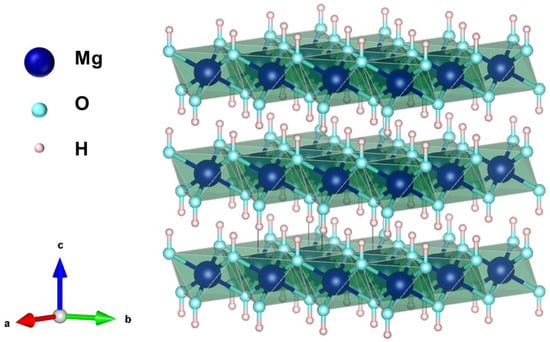
Figure 1.
Crystal structure of brucite (Mg(OH)2).
CO32− ions have a very strong affinity and strong coupling effect on the sheet, but Cl− ions have a weak affinity and are difficult to replace carbonate, so it needs to be carried out in the NaCl-HCl system [24,25]. After decarburization, the interlayer intercalation can be completely replaced by ion exchange, which can be determined by FT-IR (Figure 2a). The intense absorption bands at 1349 cm−1 and 783 cm−1 are attributed to C-O stretching vibration and antisymmetric stretching of CO32− ions and disappeared after decarburization. The intense absorption band at 1386 cm−1 is attributed to the N-O stretching vibration mode of NO3− ions, and the strong bands in the 3000–2800 cm−1 region, at 2917 and 2840 cm−1, are due to the asymmetric and symmetric CH2 stretching vibrations, respectively. In addition, the series of absorbance bands in the range of 1300–900 cm−1 is due to the stretching mode of sulfate (OSO3−). These features indicate the incorporation of these anions [26].

Figure 2.
(a) FT-IR spectra and (b) XRD patterns of LDH with different ion intercalations.
XRD patterns display that different ion intercalations have different layer spacings. The interlayer spacing of LDH with CO32−, Cl−, NO3−, and DS- are about 7.47 Å, 7.71 Å, 8.82 Å, and 25.70 Å, respectively (Figure 2b). The calculated binding energies E of LDH laminates and intercalated ions CO32−, Cl−, NO3− with formulas below:
The binding energies E of LDH and CO32−, Cl−, NO3− are 0.311 eV, 0.301 eV, and 0.071 eV, respectively. The stronger the affinity of the ions and the smaller the interlayer spacing, the more difficult it is to exfoliate into nanosheets. As for DS-, it is an organic substance with carbon chain, which is used as a commonly used anionic surfactant to electrostatic adsorb the LDH layer to further expand the layer spacing.
The CoAl-LDH-CO32− crystal is a thin hexagonal platelet with a size of 4–7 μm. The particle size distribution of LDH is shown in the inset of Figure 3a, with an average value of 5.25 μm (Figure 3a). After ion exchange, LDH is easier to be broken into small pieces (Figure 3b–d). This is because the expansion of the interlayer spacing makes it easier for water molecules to enter the interlayer, thus LDH is more easily broken in the process of ultrasonic speculation [27]. The weaker the affinity of ions, the more easily the LDH will break into fragments, which is disadvantageous to obtain large lamellae.
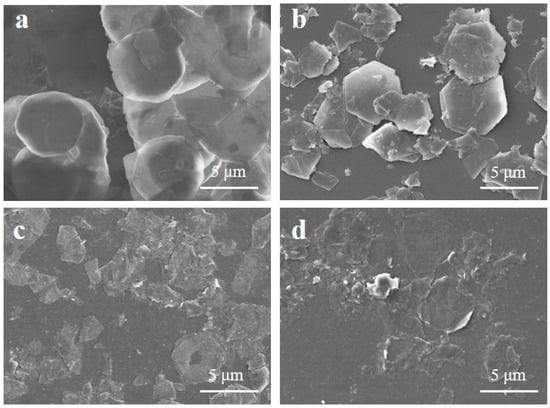
Figure 3.
SEM image of (a) CoAl-LDH-CO32− crystals, (b) after Cl− ion exchange treatment, (c) after NO3− ion exchange treatment, and (d) after DS− ion exchange treatment.
3.2. Exfoliation-Able Micron-Sized CoAl-LDH-NO3− Synthesized with One-Step Homogeneous Co-Precipitation Method
To explore the effect of the Co:Al:urea ratio on the morphology of LDH, CoAl-LDH-NO3− was synthesized in one step using the homogeneous co-precipitation method, which can be directly exfoliated. During crystallization, the hexagonal sheet layer gradually grows, but hydrotalcite with sufficient crystallization time has the same size of 4–5 μm (Figure 4a–e). The initial metal ratio in the solution does not affect the morphology of LDH. The Co:Al ratio of the platy particles is about 2:1 as determined by the crystal chemical formula, irrespective of the starting solution. Cation ordering in the brucite-like sheet may be a reason for the present products to have a constant Co:Al value of 2:1 [28,29]. It is unexpected that the Co:Al ratio in the starting solution affects the initiation time of LDH nucleation. The sequence of nucleation follows Co:Al = 3:1, 3.5:1, 4:1, 2:1, and finally 2.5:1. The reason for this is still unclear because different Co:Al ratios are independent of the enthalpy of formation of LDH [30]. Presumably, it should be related to the pH value differences caused by Co(NO3)2·6H2O, which dissolved in water is weakly acidic, and the higher the pH value, the easier the formation of LDH. Therefore, the more Co(NO3)2·6H2O in the initial solution, the later the nucleation. As for Co:Al = 2:1 and 2.5:1, which is the latest nucleation, it is not in the best M2+: M3+ range of LDH preparation.

Figure 4.
SEM image of LDH with different Co:Al:urea ratios. SEM of LDH with different Co:Al ratios = (a) 2:1:10, (b) 2.5:1:10, (c) 3:1:10, (d) 3.5:1:10, (e) 4:1:10, SEM of LDH with different urea ratios = (f) 3:1:5, (g) 3:1:15.
To clarify the effect of pH value on LDH morphology, change the amount of alkali used in the experiment. Based on measurements of solubility products of (Mg4Al2(OH)12)CO3·nH2O, it was concluded that the thermodynamic stability of the LDHs is greater than that of the corresponding M2+ hydroxides below 9 (M2+ = Co) [4,31]. The urea is used as the alkali source, the urea solution is neutral at low temperatures, and the pH value rises slowly above 90 °C and remains stable with the slow decomposition of urea [32]. Urea is hydrolyzed to provide hydroxyl ions slowly and continuously for the formation of LDH. The crystal growth is not sufficient when the urea content is low and the precipitation occurs at the latest during the preparation (Figure 4f). With the increase of urea content, the crystal growth is gradually sufficient, and the precipitation product also appears earlier during the preparation (Figure 4c,g). Therefore, LDH-NO3− prepared by homogeneous co-precipitation with complete hexagonal shape and high crystallinity can only be prepared if the metal ratio, urea content, temperature, and heating time are coordinated.
3.3. Exfoliated Nanoscale-Sized CoAl-LDH-NO3− Synthesized with High Saturation Coprecipitation Method
LDH prepared by the high saturation co-precipitation method generally has low crystallinity and can synthesize small layered crystals [29]. TEM image shows that the addition of formamide can significantly reduce the size of LDH. When formamide contains 0%, LDH nanosheets have a distinct hexagonal shape (Figure 5a). The average particle size of the LDH nanosheets is 99.12 nm, and the particle size distribution is concentrated at 60–140 nm (Figure 5d). When the formamide content is 50%, the formed LDH nanosheets are significantly reduced and lose hexagonal shape (Figure 5b), and the particle size distribution is more concentrated, the particle size distribution is concentrated at 60–80 nm, and the average particle size is 71.28 nm reduced by 28.1% (Figure 5e). When the formamide content is 100%, the LDH nanosheets are further reduced (Figure 5c). The particle size distribution is concentrated at 50–70 nm, and the average particle size is 66.26 nm reduced by 7.0% (Figure 5f). Formamide act as an effective layer growth inhibitor, attaching to the surface of LDH nanosheets, allowing LDH sheets to grow laterally, weakening interlayer forces, and inhibiting interlayer growth [33,34]. The presence of formamide weakens the electrostatic interactions between the positively charged sheets and the negatively charged counterions, which in turn reduces layer–layer interactions [35].
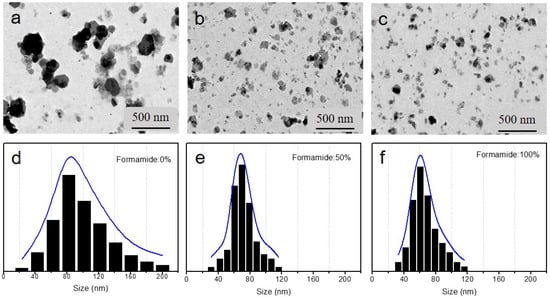
Figure 5.
TEM image and particle size distribution of LDH by high saturation coprecipitation method with different formamide content. The TEM image with formamide content of (a) 0%, (b) 50%, (c) 100%, the particle size distribution with formamide content of (d) 0%, (e) 50%, (f) 100%.
Interestingly, in macroscopic observation of LDH powders, the color of LDH powders prepared from different formamide content varies greatly. With the increase of formamide, the color gradually changes from black to dark pink to light pink (Figure 6b–d). Color changes have also been mentioned in previous studies, dark powder contains the byproduct Co3O4, which is also consistent with the reflections of the XRD pattern [28] (Figure 6a). The addition of formamide can inhibit the generation of byproducts. It can also lead to a lower crystallinity, which is consistent with the reduction of crystal size in TEM results.

Figure 6.
XRD pattern and photographs of LDH powder by high saturation coprecipitation method with different formamide content. (a) XRD pattern of LDH powder by high saturation coprecipitation method with different formamide content, and photograph of LDH powder by high saturation coprecipitation method with different formamide content (b) 0%, (c) 50%, (d) 100%.
The particle size distribution concentration range is 40–100 nm without NaNO3 (Figure 7a,d). After the addition of NaNO3, the size distribution of the particles is concentrated at 35–80 nm (Figure 7b,e). Furthermore, with the increase of NaNO3 content, the distribution range of particle size decreases to 40–70 nm (Figure 7c,f). The particle size distribution that the addition of NaNO3 can make the growth of LDH nanosheets more uniform, showing a stronger monodispersity.
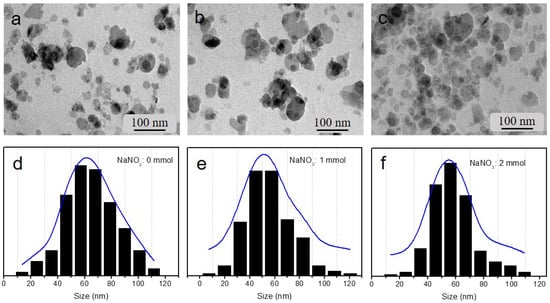
Figure 7.
TEM image and particle size distribution of LDH by high saturation coprecipitation method with different NaNO3 content. The TEM image with different NaNO3 content of (a) 0 mmol, (b) 1 mmol, (c) 2 mmol, and the particle size distribution with different NaNO3 content of (d) 0 mmol, (e) 1 mmol, (f) 2 mmol.
According to the XRD patterns, LDH prepared by different amounts of NaNO3 additions have the same crystal structure (Figure 8). However, after NaNO3 participates in the reaction, impurity appears according to the XRD pattern, which should be unreacted NaNO3. In addition, the (012) crystal face reflection is greater than the (015) crystal face reflection is a feature of the superposition mode (00l) in the 3R1 stacking sequences [36].The prismatic arrangement of hydroxyl groups allows those in both upper and lower layers to form hydrogen bonds with the oxygen atoms of the carbonate anions [37]. It is worth noting that the (015) peak gradually decreases with the addition of NaNO3. The tendency of the (012) peak to be larger than the (015) peak gradually diminishes. If the (015) peak is higher than the (012) peak and the (10l) peak appears, it proves that the LDH crystal is of 3R2 type, most of the interlayer anions are -OH, and the crystal grows layer by layer along the (101) crystal plane. This indicates that the addition of NaNO3 may change the stacking pattern of crystal growth [37].
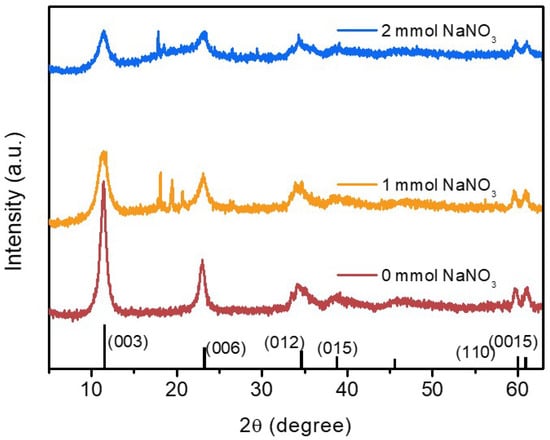
Figure 8.
XRD patterns of LDH by high saturation coprecipitation method with different NaNO3 content.
3.4. Effect of M2+ Al-LDH Synthesized by High Saturation and Homogeneous Co-Precipitation on Crystal Structure
LDH of different M2+ was prepared using high saturation co-precipitation and homogeneous co-precipitation, respectively. Regardless of the LDH of a M2+, the zeta potential of LDH prepared by homogeneous co-precipitation is always greater than the zeta potential of LDH prepared by high saturation co-precipitation. The zeta potential difference of ZnAl-LDH and MgAl-LDH is inconspicuous. The zeta potential difference of MgAl-LDH with high saturation co-precipitation and uniform co-precipitation method are 52.5 mV and 54.2 mV. The zeta potential of ZnAl-LDH are 77.8 mV and 81.9 mV under the same condition. However, the zeta potential of the CoAl-LDH prepared by the two methods varies greatly, which were 63.7 mV and 98.2 mV (Figure 9). The zeta potential of MgAl-LDH is always the lowest in both preparation methods. This is consistent with the oxidative order of the metal cations.
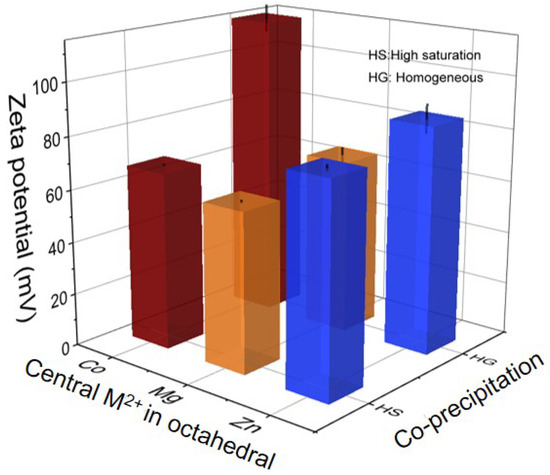
Figure 9.
Zeta potential of LDH with different divalent metals.
The morphology of LDH of different M2+ prepared by the high saturation co-precipitation method did not form a complete hexagonal shape, and the size also varied greatly, with the average sizes of CoAl-LDH, MgAl-LDH, and ZnAl-LDH being 42.3 nm, 36.0 nm, and 452.4 nm, respectively (Figure 10a–c). The different size of LDH for different M2+ should be also associated with the thermodynamic stability of LDH generation. A simple thermodynamic model can be used to determine the standard molar Gibbs free energy of LDHs formation: (1–3x/2)M2+(OH)2+xM3+(OH)3+(x/2)M2+(An−)2/n = [M2+1−xM3+x(OH)2](An−)x/n, and the resulting LDH stability of M2+ is in the order Mg < Co < Zn. The higher the standard molar Gibbs free energy, the earlier the nucleation and the larger the grain size [38]. CoAl-LDH, MgAl-LDH, and ZnAl-LDH prepared by homogeneous co-precipitation method have a full hexagonal shape with similar sizes of about 4–6 μm (Figure 10d–f). In the homogeneous co-precipitation method, urea as an alkali source can continue to release -OH, the solution continues to maintain a high pH, and the LDH crystals have enough time to grow, therefore the size is similar. However, the high saturation co-precipitation method has low crystallinity caused by the addition of formamide and may lose hexagonal lamellae after crystal growth. The amide group and carboxyl group of formamide can coordinate with M2+ and M3+, occupy the position of -OH, and affect the crystal growth along the c-axis direction.
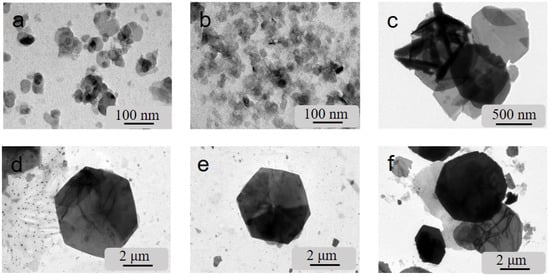
Figure 10.
TEM image of LDH with different divalent metals. LDH prepared by high saturation co-precipitation with different divalent metals (a) Co2+, (b) Mg2+, and (c) Zn2+; LDH prepared by uniform co-precipitation with different divalent metals (d) Co2+, (e) Mg2+, and (f) Zn2+.
Among the three kinds of LDH with different M2+ prepared by high saturation co-precipitation, the reflections of ZnAl-LDH indicated high crystallinity, which corroborates with the results of XRD (Figure 11a). In addition, (110) reflection reflects the size of the lattice constant a0, i.e., the metal radius. It can be calculated with the equation a0 = 2·d(110). The (110) reflection of CoAl-LDH, MgAl-LDH, and ZnAl-LDH are located at 2θ = 59.7°, 60.5°, and 60.3°, corresponding to a0 = 0.773 Å, 0.764 Å, 0.767 Å, respectively [39,40] (Figure 11b). This is related to the atomic radius of the M2+. Among three kinds LDHs with different M2+ prepared by homogeneous co-precipitation, the ZnAl-LDH has the highest crystallinity (Figure 11c). Similar to the three LDHs prepared by the high saturation co-precipitation method, the unit cell parameters a0 of CoAl-LDH, MgAl-LDH, and ZnAl-LDH were calculated by the same method, and the results were 0.770 Å, 0.756 Å, and 0.769 Å, respectively [41] (Figure 11d).

Figure 11.
XRD pattern of LDH with different divalent metals prepared by (a,b) high saturation co-precipitation, (c,d) by uniform co-precipitation.
4. Conclusions
Micron and nano LDH were prepared through co-precipitation methods for morphology control. The layer spacing can be adjusted by the ion exchange. The purpose of exfoliation of LDH-CO32− can also be achieved by gradually increasing layer spacing. The order of binding energy of different intercalated ions is as follows: CO32−, Cl−, NO3−. It can be inferred that the difficulty of exfoliating depends on the interlayer spacing and the affinity between LDH laminates and interlayer ions. LDH-NO3− can be directly exfoliated, and high crystallinity can be obtained under the condition that Co:Al:urea, heating time, and temperature are coordinated. LDH nanosheets can also be prepared in one step, and smaller and purer nanosheets can be prepared by using formamide as the reaction solvent. When half of the reaction solvent uses formamide, the size of LDH decreases by 28.1%, and when all of the reaction solvent uses formamide, the size of LDH further decreases by 7.0%. Furthermore, the addition of NaNO3 leads to a stronger monodispersity of LDH nanosheets. Moreover, LDHs with different M2+ have different standard molar Gibbs free energy. However, MAl-LDHs with lower standard molar Gibbs free energy result in a larger nanosheet only with high saturation co-precipitation method, and negligible difference in the size and shape with homogeneous co-precipitation. It is of great significance to control the morphology of the irreplaceable positively charged 2D lamellae for the development of functional materials with 2D nanosheets as components.
Author Contributions
Conceptualization, Y.Z. (Yi Zhou); methodology, C.W.; validation, C.W.; formal analysis, C.W.; investigation, C.W., X.Y., W.X., Y.G.; writing—original draft preparation, C.W.; writing—review and editing, X.Y., Y.Z. (Yi Zhou), Y.Z. (Yihe Zhang), and N.Z.; supervision, Y.Z. (Yi Zhou), Y.Z. (Yihe Zhang), and N.Z.; funding acquisition, Y.Z. (Yi Zhou) and N.Z. All authors have read and agreed to the published version of the manuscript.
Funding
National Natural Science Foundation of China (42102033, 52174388); Fundamental Re-search Funds for the Central Universities (2652019032, 2652019034).
Data Availability Statement
Not applicable.
Acknowledgments
Not applicable.
Conflicts of Interest
The authors declare no conflict of interest.
References
- Goh, K.H.; Lim, T.T.; Dong, Z. Application of layered double hydroxides for removal of oxyanions: A review. Water Res. 2008, 42, 1343–1368. [Google Scholar] [CrossRef] [PubMed]
- Cui, S.; Zhang, R.; Peng, Y.; Gao, X.; Li, Z.; Fan, B.; Guan, C.Y.; Beiyuan, J.; Zhou, Y.; Liu, J.; et al. New insights into ball milling effects on MgAl-LDHs exfoliation on biochar support: A case study for cadmium adsorption. J. Hazard. Mater. 2021, 416, 126258. [Google Scholar] [CrossRef] [PubMed]
- Hu, Z.Q.; Chen, G.M. Novel Nanocomposite Hydrogels Consisting of Layered Double Hydroxide with Ultrahigh Tensibility and Hierarchical Porous Structure at Low Inorganic Content. Adv. Mater. 2014, 26, 5950–5956. [Google Scholar] [CrossRef] [PubMed]
- He, J.; Wei, M.; Li, B.; Kang, Y.; Evans, D.G.; Duan, X. Preparation of Layered Double Hydroxides. In Layered Double Hydroxides; Structure and Bonding; Springer: Berlin, Heidelberg, 2006; pp. 89–119. [Google Scholar] [CrossRef]
- Wang, Y.; Mei, X.; Bian, Y.; Hu, T.; Weng, X.; Liang, R.; Wei, M. Magnesium-based layered double hydroxide nanosheets: A new bone repair material with unprecedented osteogenic differentiation performance. Nanoscale 2020, 12, 19075–19082. [Google Scholar] [CrossRef]
- Yu, J.F.; Wang, Q.; O’Hare, D.; Sun, L.Y. Preparation of two dimensional layered double hydroxide nanosheets and their applications. Chem. Soc. Rev. 2017, 46, 5950–5974. [Google Scholar] [CrossRef]
- Nosrati, H.; Seidi, F.; Hosseinmirzaei, A.; Mousazadeh, N.; Mohammadi, A.; Ghaffarlou, M.; Danafar, H.; Conde, J.; Sharafi, A. Prodrug Polymeric Nanoconjugates Encapsulating Gold Nanoparticles for Enhanced X-ray Radiation Therapy in Breast Cancer. Adv. Healthc. Mater. 2022, 11, e2102321. [Google Scholar] [CrossRef]
- Wang, L.; Zhang, B.; Yang, X.; Guo, S.; Waterhouse, G.I.N.; Song, G.; Guan, S.; Liu, A.; Cheng, L.; Zhou, S. Targeted alleviation of ischemic stroke reperfusion via atorvastatin-ferritin Gd-layered double hydroxide. Bioact. Mater. 2023, 20, 126–136. [Google Scholar] [CrossRef]
- Ashrafizadeh, M.; Nazarzadeh Zare, E.; Rossi, F.; Rabiee, N.; Sharifi, E.; Makvandi, P. Photoactive polymers-decorated Cu-Al layered double hydroxide hexagonal architectures: A potential non-viral vector for photothermal therapy and co-delivery of DOX/pCRISPR. Chem. Eng. J. 2022, 448, 137747. [Google Scholar] [CrossRef]
- Guo, Z.; Xie, W.; Lu, J.; Guo, X.; Chi, Y.; Wang, D.; Takuya, N.; Xu, W.; Ye, J.; Liu, X.; et al. Ferrous ions doped layered double hydroxide: Smart 2D nanotheranostic platform with imaging-guided synergistic chemo/photothermal therapy for breast cancer. Biomater. Sci. 2021, 9, 5928–5938. [Google Scholar] [CrossRef]
- Santos, R.M.M.; Tronto, J.; Briois, V.; Santilli, C.V. Thermal decomposition and recovery properties of ZnAl-CO3 layered double hydroxide for anionic dye adsorption: Insight into the aggregative nucleation and growth mechanism of the LDH memory effect. J. Mater. Chem. A 2017, 5, 9998–10009. [Google Scholar] [CrossRef]
- Bascialla, G.; Regazzoni, A.E. Immobilization of anionic dyes by intercalation into hydrotalcite. Colloids Surf. A Physicochem. Eng. Asp. 2008, 328, 34–39. [Google Scholar] [CrossRef]
- Zhang, H.; Li, K.; Liang, Z.; Wan, Y.; Feng, Z.; Liu, J.; Zhang, Q.; Wang, M. Replacement of interlayer anion via memory effect of layered double hydroxide: A promising strategy for fabricating nanostructures with better flame-retardant performance. J. Phys. Chem. Solids 2022, 170, 110932. [Google Scholar] [CrossRef]
- Liu, Z.; Ma, R.; Osada, M.; Iyi, N.; Ebina, Y.; Takada, K.; Sasaki, T. Synthesis, anion exchange, and delamination of Co-Al layered double hydroxide: Assembly of the exfoliated nanosheet/polyanion composite films and magneto-optical studies. J. Am. Chem. Soc. 2006, 128, 4872–4880. [Google Scholar] [CrossRef]
- Song, F.; Hu, X. Exfoliation of layered double hydroxides for enhanced oxygen evolution catalysis. Nat. Commun. 2014, 5, 4477. [Google Scholar] [CrossRef]
- Liu, Y.; Wang, N.Y.; Caro, J. In situ formation of LDH membranes of different microstructures with molecular sieve gas selectivity. J. Mater. Chem. A 2014, 2, 5716–5723. [Google Scholar] [CrossRef]
- Zhou, C.H.; Shen, Z.F.; Liu, L.H.; Liu, S.M. Preparation and functionality of clay-containing films. J. Mater. Chem. 2011, 21, 15132–15153. [Google Scholar] [CrossRef]
- Xin, Y.; Dai, X.; Lv, G.; Wei, X.; Li, S.; Li, Z.; Xue, T.; Shi, M.; Zou, K.; Chen, Y.; et al. Stability-Enhanced α-Ni(OH)2 Pillared by Metaborate Anions for Pseudocapacitors. ACS Appl. Mater. Interfaces 2021, 13, 28118–28128. [Google Scholar] [CrossRef]
- Yang, Y.Y.; Zhu, P.L.; Zhang, L.C.; Zhou, F.R.; Li, T.X.; Bai, R.Q.; Sun, R.; Wong, C.P. Electrodeposition of Co(OH)2 Improving Carbonized Melamine Foam Performance for Compressible Supercapacitor Application. ACS Sustain. Chem. Eng. 2019, 7, 16803–16813. [Google Scholar] [CrossRef]
- Shang, J.; Zhang, Y.; Zhang, Q.; Li, Y.; Deng, F.; Gao, R.; Wang, J. A novel interlaced NiCoFe hydrotalcite assembled by nanorods and nanosheets with enhanced electrochemical performance for supercapacitor. J. Alloys Compd. 2022, 925, 166668. [Google Scholar] [CrossRef]
- Usui, H.; Sasaki, T.; Koshizaki, N. Formation Process of Platelet Nanocomposites with Zinc Hydroxide and Sodium Dodecyl Sulfate Prepared by Laser Ablation in Solution. Chem. Lett. 2006, 35, 752–753. [Google Scholar] [CrossRef]
- Usui, H.; Sasaki, T.; Koshizaki, N. Effect of Alkyl Chain Length on Layered Structure of Zn Nanocomposites Prepared by Laser Ablation of Zn in Aqueous Solution of Sodium Alkyl Sulfate. Chem. Lett. 2005, 34, 700–701. [Google Scholar] [CrossRef]
- Taylor, H.F.W. Crystal structures of some double hydroxide minerals. Mineral. Mag. 1973, 39, 377–389. [Google Scholar] [CrossRef]
- Iyi, N.; Matsumoto, T.; Kaneko, Y.; Kitamura, K. Deintercalation of carbonate ions from a hydrotalcite-like compound: Enhanced decarbonation using acid-salt mixed solution. Chem. Mater. 2004, 16, 2926–2932. [Google Scholar] [CrossRef]
- Li, L.; Ma, R.Z.; Ebina, Y.; Iyi, N.; Sasaki, T. Positively charged nanosheets derived via total delamination of layered double hydroxides. Chem. Mater. 2005, 17, 4386–4391. [Google Scholar] [CrossRef]
- Hibino, T.; Jones, W. New approach to the delamination of layered double hydroxides. J. Mater. Chem. 2001, 11, 1321–1323. [Google Scholar] [CrossRef]
- Si, Y.; Samulski, E.T. Synthesis of water soluble graphene. Nano Lett. 2008, 8, 1679–1682. [Google Scholar] [CrossRef]
- Kayano, M.; Ogawa, M. Preparation of large platy particles of Co-Al layered double hydroxides. Clays Clay Miner. 2006, 54, 382–389. [Google Scholar] [CrossRef]
- Evans, D.G.; Slade, R.C.T. Structural Aspects of Layered Double Hydroxides; Springer: Berlin/Heidelberg, Germany, 2005; Volume 119, pp. 1–87. [Google Scholar] [CrossRef]
- Rozov, K.B.; Berner, U.; Kulik, D.A.; Diamond, L.W. Solubility and thermodynamic properties of carbonate-bearing hydrotalcite–pyroaurite solid solutions with a 3:1 Mg/(Al+Fe) mole ratio. Clays Clay Miner. 2011, 59, 215–232. [Google Scholar] [CrossRef]
- Bravo-Suarez, J.J.; Paez-Mozo, E.A.; Oyama, S.T. Review of the synthesis of layered double hydroxides: A thermodynamic approach. Quim. Nova 2004, 27, 601–614. [Google Scholar] [CrossRef]
- Kostadinova, D.; Cenacchi Pereira, A.; Lansalot, M.; D’Agosto, F.; Bourgeat-Lami, E.; Leroux, F.; Taviot-Gueho, C.; Cadars, S.; Prevot, V. Intercalation and structural aspects of macroRAFT agents into MgAl layered double hydroxides. Beilstein J. Nanotechnol. 2016, 7, 2000–2012. [Google Scholar] [CrossRef]
- Yu, J.; Martin, B.R.; Clearfield, A.; Luo, Z.; Sun, L. One-step direct synthesis of layered double hydroxide single-layer nanosheets. Nanoscale 2015, 7, 9448–9451. [Google Scholar] [CrossRef]
- Hibino, T. Delamination of layered double hydroxides containing amino acids. Chem. Mater. 2004, 16, 5482–5488. [Google Scholar] [CrossRef]
- Essex, J.W.; Jorgensen, W.L. Dielectric constants of formamide and dimethylformamide via computer simulation. J. Phys. Chem. 1995, 99, 17956–17962. [Google Scholar] [CrossRef]
- Bookin, A.S. Polytype Diversity of the Hydrotalcite-Like Minerals I. Possible Polytypes and their Diffraction Features. Clays Clay Miner. 1993, 41, 551–557. [Google Scholar] [CrossRef]
- Newman, S.P.; Jones, W.; O’Connor, P.; Stamires, D.N. Synthesis of the 3R2 polytype of a hydrotalcite-like mineral. J. Mater. Chem. 2002, 12, 153–155. [Google Scholar] [CrossRef]
- Prinetto, F.; Ghiotti, G.; Graffin, P.; Tichit, D. Synthesis and characterization of sol-gel Mg/Al and Ni/Al layered double hydroxides and comparison with co-precipitated samples. Microporous Mesoporous Mater. 2000, 39, 229–247. [Google Scholar] [CrossRef]
- Ai, Z.Q.; Liu, C.Q.; Zhang, Q.W.; Qu, J.; Li, Z.; He, X.M. Adding ZnO and SiO2 to scatter the agglomeration of mechanochemically prepared Zn-Al LDH precursor and promote its adsorption toward methyl orange. J. Alloys Compd. 2018, 763, 342–348. [Google Scholar] [CrossRef]
- He, Y.; Wang, R.; Jiao, T.; Yan, X.; Wang, M.; Zhang, L.; Bai, Z.; Zhang, Q.; Peng, Q. Facile Preparation of Self-Assembled Layered Double Hydroxide-Based Composite Dye Films as New Chemical Gas Sensors. ACS Sustain. Chem. Eng. 2019, 7, 10888–10899. [Google Scholar] [CrossRef]
- Yang, N.; Ma, J.; Shi, J.; Gao, D. pH-triggered MgAlZr layered double hydroxides for modification of collagen fibers with enhanced thermal stability and UV resistance. Appl. Clay Sci. 2020, 198, 105827. [Google Scholar] [CrossRef]
Publisher’s Note: MDPI stays neutral with regard to jurisdictional claims in published maps and institutional affiliations. |
© 2022 by the authors. Licensee MDPI, Basel, Switzerland. This article is an open access article distributed under the terms and conditions of the Creative Commons Attribution (CC BY) license (https://creativecommons.org/licenses/by/4.0/).